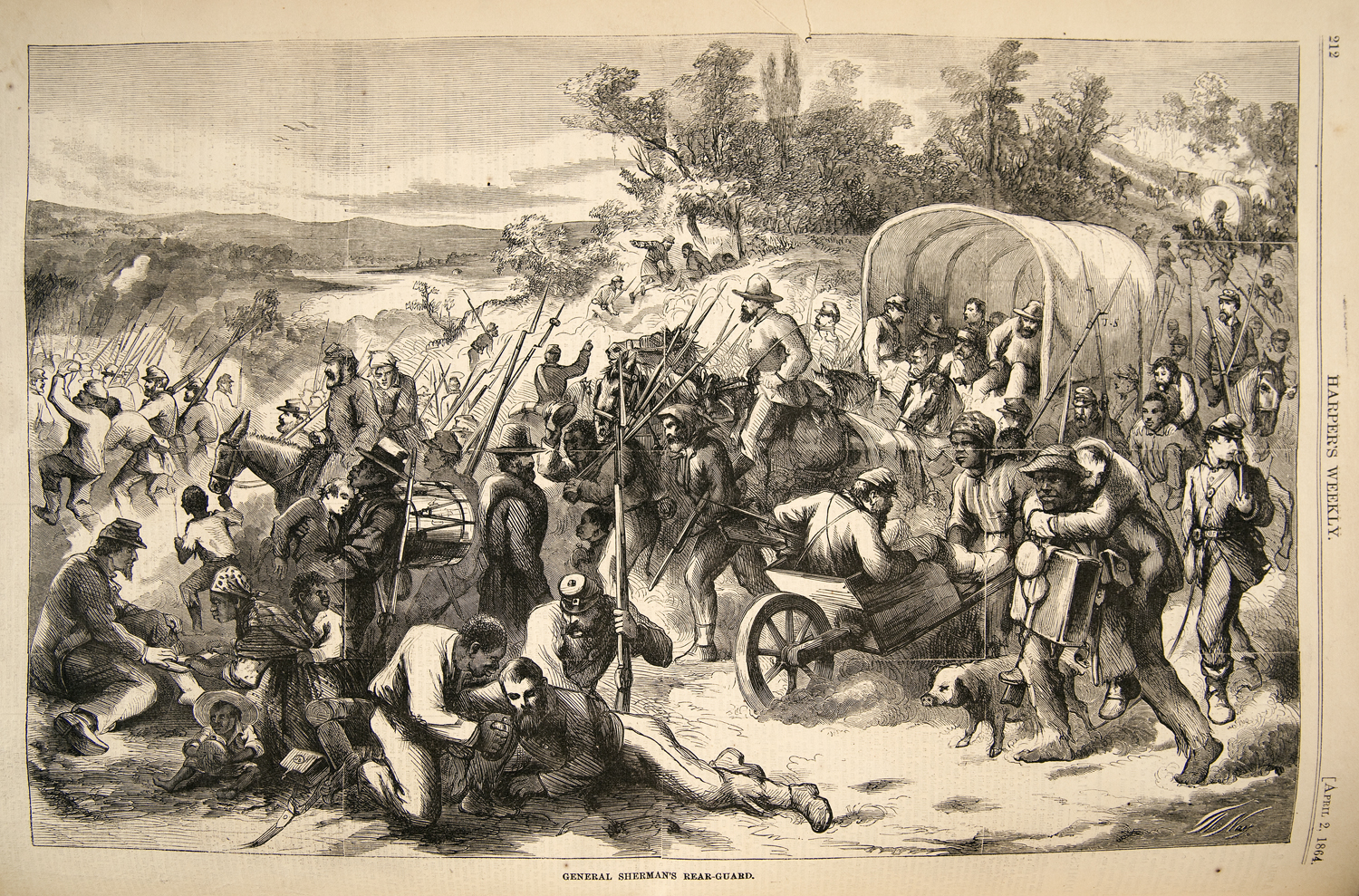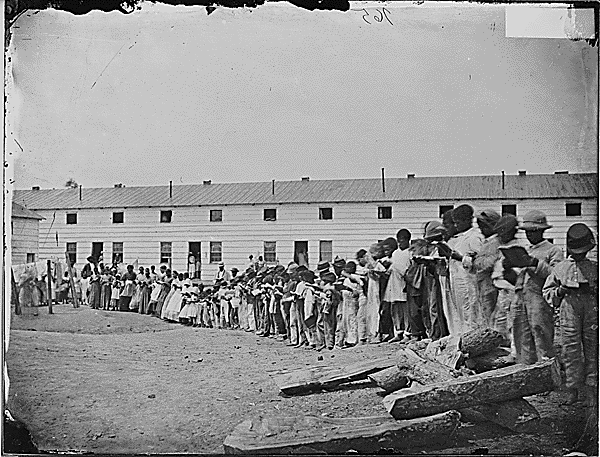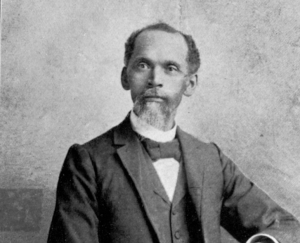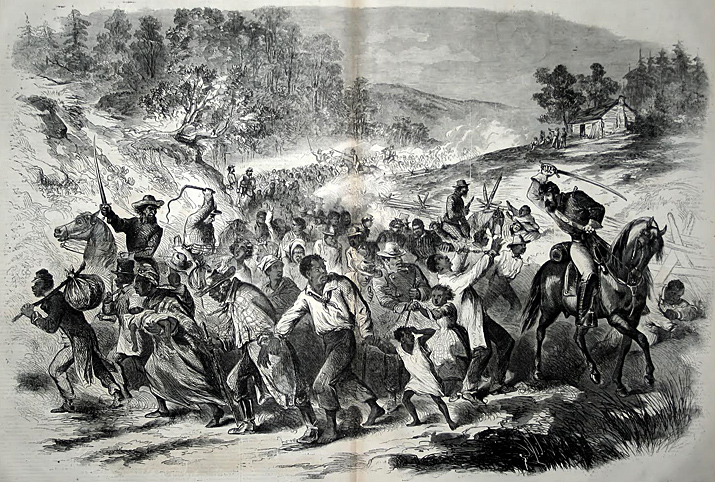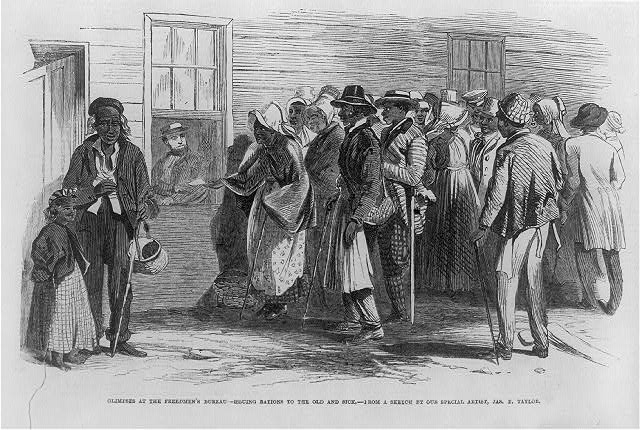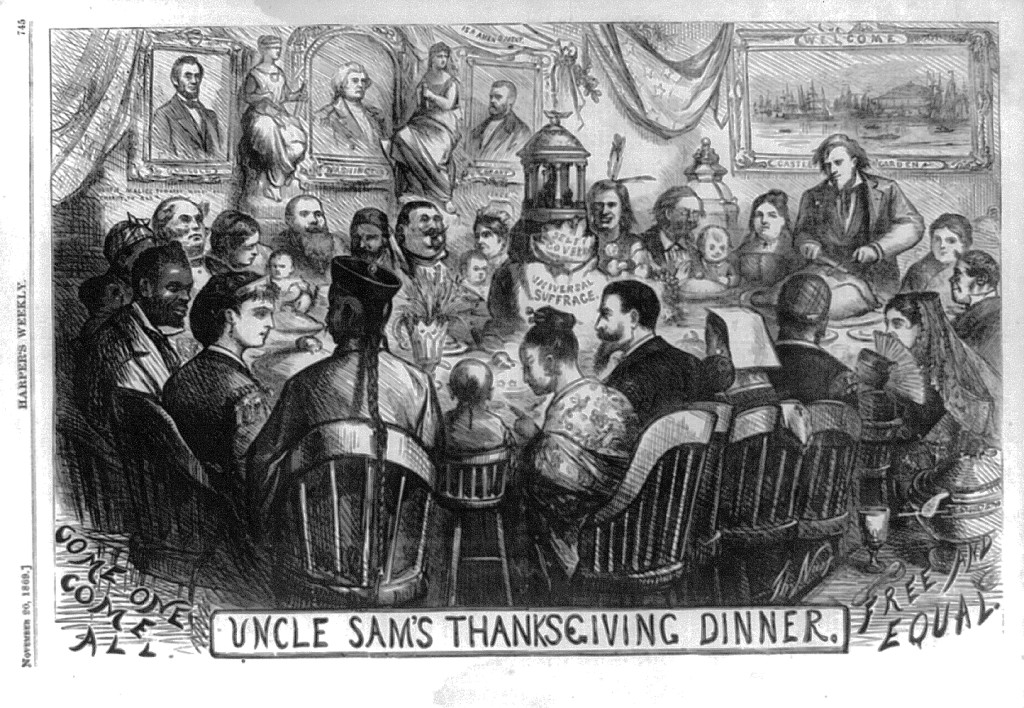by Curtis Harris
Refugees – persons seeking safety and refuge from war, famine, and other upheavals – have been an integral, constant part of American history. The Trail of Tears exemplified the arduous saga Native Americans endured seeking a safe haven. The Mormons who established Utah did so as refugees escaping religious persecution in the eastern United States. Large numbers of German immigrants in the late 1840s and 1850s were political refugees fleeing retribution after their failed 1848 revolution to establish democracy.
The history of slavery, too, is one of refugees. Whether captured in Africa, sold “down river” in the United States, or trafficked in modern-day bondage, enslaved persons are constantly in search of asylum to be free. If they ever find refuge, these persons then must take on the grueling tasks of reuniting with loved ones, seeking work, securing education, and finding food.
Thus it’s unsurprising that the Civil War – product of the conflict over slavery in the U.S. – produced one of the largest refugee crises of the 19th century. Although few American refugees crossed international lines, the crisis was nonetheless very real for those who endured it.
To address this upheaval, Congress passed a bill to establish the Bureau of Refugees, Freedmen, and Abandoned Lands – commonly referred to as the Freedmen’s Bureau. Abraham Lincoln signed the bill into law on March 3, 1865. This was the final act signed into law by President Lincoln, but it was not his first experience with the Civil War’s refugee crisis.
REFUGEES IN MR. LINCOLN’S WASHINGTON
When the Civil War began, enslaved persons across the South sought refuge with the United States Army. The pressure they applied forced officials in Washington to devise the “contraband” policy in the summer of 1861. The refugee crisis rose further in April 1862 when President Lincoln signed the D.C. Emancipation Act. With the nation’s capital finally free soil, black Americans from neighboring Maryland and Virginia rushed to D.C. finding refuge from enslavement.
Lincoln’s Emancipation Proclamation, often considered in political or military terms, committed the U.S. Army and Navy to the role of refuge and asylum for the formerly enslaved declaring that “the Executive government of the United States, including the military and naval authorities thereof, will recognize and maintain the freedom of said persons.”
Some of the camps refugees settled in were along President Lincoln’s commuting route to and from the Cottage. Persons living in the camps recalled meeting Lincoln, talking with him, and even singing with the President. Elizabeth Keckley – a friend of the Lincoln family – started the Contraband Relief Association to aid the refugees. Addressing her husband in a letter in the fall of 1862, Mary Lincoln supported Keckley’s endeavor by reallocating $200 originally destined for military hospitals:
“[Elizabeth Keckley] says the immense number of Contrabands in W[ashington] are suffering intensely, many without bed covering & having to use any bits of carpeting to cover themselves [and] many dying of want…. I am sure you will not object to [the money] being used in this way – The cause of humanity requires it.”
The refugee crisis in D.C. brought the situation home for the Lincoln’s, but it was indeed a national problem. Food shortages caused the displacement of many Southerners – white and black, Unionist and Confederate. White Americans in the South were forced into refugee status for other reasons as well.
From the war’s outset, Unionists faced persecution from the Confederate government. The mountainous and hilly regions of Arkansas, Texas, Tennessee, North Carolina, and Alabama became particular hotspots for Unionist refugees. As the war dragged on, increasing numbers of men became refugees as they sought to avoid military service – either by deserting their respective army or dodging the draft. Southern whites typically found asylum in the mountainous areas mentioned before, while some Northerners took refuge in Canada.
FINDING REFUGE FROM THE LAND OF BONDAGE
Louis Hughes published his autobiography, Thirty Years a Slave: From Bondage to Freedom, in 1897 recalling his life as a slave and a freeman. It is one of dozens of such narratives written after the war by black Americans. In their stories one can find harrowing tales of persons seeking refuge.
In 1862 Hughes, his wife Matilda, Alfred and Lydia Dandridge, and Matt Dandridge set out from a plantation in western Tennessee headed for Memphis, then occupied by U.S. Army troops. Hughes and his party weren’t alone in seeking asylum in Memphis. In 1860 the city’s black population stood at just 3,000. By 1865 the black population had grown to 22,000 due to the influx of refugees from the surrounding farmland.
“We planned to make a careful and persistent effort to escape from the land of bondage,” Hughes remembered as they prepared for their journey to freedom:
“After we had traveled about twelve miles, we came to a swamp called Hicke-Hally. Here we stopped, as day was dawning, and settled down for the day, as we could travel only in the night, lest we should be seen and caught. We were wet – our clothes soaked through from the heavy dew. We had to travel through corn fields, cotton patches, oat fields and underbrush, not daring to take the main road…. When within four or five miles of Cold Water, Uncle Alfred stopped [and] cautioned us not to speak above a whisper, as the rebel troops were camped on both sides of us.”
Quietly setting up camp for the day – remember they did not travel at night – their escape plan nonetheless met disaster. Slave-catchers and bloodhounds caught the entire party. As they were taken back to the plantation, the would-be refugees were taunted by an elderly white woman, “You niggers going to the Yankees? You all ought to be killed.” Arriving at the plantation, the mistress of the property accosted Matilda Hughes, “I thought you were a Christian. You’ll never see your God.”
“She seemed to think,” Louis Hughes recalled, “that because Matilda had sought freedom she had committed a great sin.” This was Hughes’s fourth failed attempt at freedom.
Louis and Matilda Hughes finally escaped the land of bondage in July 1865 – three months after the Civil War ended and two-and-a-half years after the Emancipation Proclamation. When they finally reached Memphis, Hughes recalled that “It was appropriately the 4th of July when we arrived…. Thousands of others, in search of the freedom of which they had so long dreamed, flocked into the city of refuge, some having walked hundreds of miles.”
THE “PECULIAR INSTITUTION’S” OTHER REFUGEE CRISIS
Andrew Ward, author of The Slaves’ War, described another, peculiar refugee crisis of the Civil War as “perhaps the most hapless and futile migration in American history, [as] thousands of masters set off for the Deep South or the Far West to keep their slaves out of the liberating reach of the Union Army.”
Enslaved people were “refugeed” by masters eluding emancipation. This tactic not only reduced enslaved people’s chances to find freedom, but also meant separation from their family. The experience of walking hundreds of miles also spelled death for many young, elderly, and sickly persons on the forced marches.
Here are some of the recollections of those who survived the marches:
“[My] white master took [his slaves] into the bottoms and hid them, so they couldn’t run off with the Yankee soldiers.” – Elizabeth Hines
“That was sure some trip when us come to Texas. Old Master had done been to Texas and traveled round through the state looking for a place to locate. [He purchased] 320 acres of land at what they call Whitehall [near Waco]. There weren’t no roads much, nor no bridges in Texas…. It took us about three months to get to the place in McLennan County where us going to locate.” – Jake Wilson
“While we was on our way [to Arkansas], Old Master died, and three of the slaves died too. We buried the slaves there [on the route], but we camped while Old Master was carried back to North Carolina.” – Millie Evans
As the war concluded and the authority of the United States was once again being enforced, many Confederates decided to flee the U.S. for foreign lands. Brazil proved to be a particularly popular asylum since it still maintained slavery. These peculiar political refugees could not stomach the thought of emancipation.
Major Joseph Abney, president of a company that colonized Confederate planters, believed that it was impossible for “the negro to labor without coercion.” Emancipation meant a “deeper degree of destruction and want is inevitable and as the negro will not work, and must eat, hunger and starvation, and madness and crime will run riot through our borders and there is no earthly power that can interpose to save us and our children…”
For the refugees who remained in the United States, Congress and President Lincoln set about to create a formal, federalized channel to address their needs as the war closed.
THE BUREAU
The Bureau of Refugees, Freedmen, and Abandoned Lands established in March 1865 cared for the mass of refugees in the South – whether white or black. The Bureau quickly found its work challenged not only by the destruction wrought by the war, but more ominously by the Black Codes of Southern governments. These laws sought to re-establish slavery in all but name by restricting mobility, employment, and educational opportunities for black Americans. Furthermore, violence against blacks and whites who had remained loyal to the United States was rampant and hindered efforts to address their refugee status.
Garrett Epps, author of Democracy Reborn, relates that “Congress initially saw the bureau as temporary; in the March 1865 bill, it was given a one-year life span.” However, the aforementioned problems across the post-war South convinced Congress to reauthorize the Bureau. Overriding the vehement veto of President Andrew Johnson, Congress not only extended the Bureau’s life, but gave it increased authority, which Epps describes:
“[The 1866 bill] authorized the bureau to build free schools for the freed slaves and to acquire land for them to farm; it permitted the bureau to distribute public lands held in the lower South for homesteads…. The bill also erected a system of military courts in any part of the nation ‘wherein the ordinary course of judicial decisions has been interrupted by the rebellion’ and [where] local ‘law, ordinance, police, or regulation, custom or prejudice’ denied to black people ‘any of the civil rights or immunities belonging to white persons.’ Included in among these ‘civil rights’ were ‘the right to make and enforce contracts, to sue, be parties, and give evidence, to inherit, purchase, lease, sell, hold and convey real property, and to have full and equal benefit of all laws and proceedings for the security of person and estate.'”
The Bureau was also charged with building hospitals, helping negotiate labor contracts, legalize marriages, and locate missing relatives. Howard University, Fisk University, and Hampton University were established by the Bureau in conjunction with philanthropic organizations. By September 1866 the Bureau had distributed 800,000 rations in Georgia alone. “While a majority of the agency’s rations went to freedpeople,” notes the New Georgia Encyclopedia, “a surprising number of poor whites benefited from bureau relief measures as well. In Georgia whites received almost one-fifth of the agency’s rations; regionwide, whites received more than a fourth.”
Writing for the Atlantic in 1901, W.E.B. DuBois estimated that from 1865 to 1869 the Bureau disbursed 21 million free rations to the destitute. Furthermore, DuBois calculated that by June 1869, over half-a-million patients had been treated at Bureau hospitals and by Bureau physicians. The Bureau helped secure land ownership as well. In Georgia, DuBois concluded that black refugees became the owners of 350,000 acres of land by 1874.
Serving as the safe space for freedmen and Unionist whites to report outrages and crimes that went unpunished by local authorities, the Bureau recorded violations and attempted to bring perpetrators to justice. Digitized records of the Bureau contain hundreds of complaints of murders, beatings, and other offenses committed against refugees across the South after the Civil War officially concluded. Although not successful in completely dispensing justice for these crimes, the Bureau often brought the first semblance of legal recourse for black Americans.
The political will to sustain the Bureau waned by the early 1870s. Northerners were looking for a return to “normalcy”, while many white Southern congressmen implored for “home rule” without the interference of federal agencies like the Bureau insisting on the rights of freedmen and providing aid to refugees of all stripes. The complaints Andrew Johnson had made in his 1866 veto message had now become the prevailing attitude. Thus in 1872, the Bureau ceased operations as Congress failed to reauthorize its mandate. This signaled the beginning of the end of national concern for the refugees and freedmen of the South.
A JUST AND LASTING PEACE
Abraham Lincoln began his second term in office on March 4, 1865, the day after he signed the Bureau into law. His Second Inaugural Address made the impassioned case for a just and lasting peace built on compassion and respect:
“With malice toward none; with charity for all; with firmness in the right, as God gives us to see the right, let us strive on to finish the work we are in; to bind up the nation’s wounds; to care for him who shall have borne the battle, and for his widow, and his orphan—to do all which may achieve and cherish a just and lasting peace among ourselves, and with all nations.”
The Bureau was an attempt to do just that. Seeking peace, it provided material aid to refugee Americans displaced by slavery, starvation, and war. It educated, fed, and nursed thousands of people who otherwise would have gone without these necessities. In the name of justice, it reported murders, false imprisonments, and other crimes to Congress that helped lead to the passage of the Civil Rights Act of 1866 and the ratification of the 14th and 15th Amendments in 1868 and 1870, respectively.
Lincoln’s plea for “a just and lasting peace among ourselves, and with all nations” was predicated on “malice toward none” and “charity for all.” As the final act signed into law by his pen, the Bureau of Refugees, Freedmen, and Abandoned Lands exemplified the noblest aim of Lincoln’s legacy.
ABOUT THE AUTHOR
Curtis Harris is a doctoral history student at American University. He has worked at President Lincoln’s Cottage for over five years, currently as a Museum Program Associate and formerly as Marketing & Membership Coordinator.
